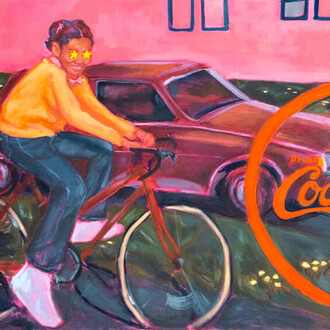Art 3 gallery is pleased to present Drawings, Rules featuring works by Owen Schuh. This will be Schuh’s first solo exhibition with the gallery. On view at ART 3 gallery, 109 Ingraham Street, Bushwick, Brooklyn, from November 9 to December 18, 2016, Wed-Sat 12-6 PM, Sun 1-5 PM. The Opening reception will take place Friday November 11, 6- 9 PM.
Owen Schuh creates artworks that draw inspiration from mathematical rules, algorithms and complex organic systems. In particular, he is fascinated by simple sets of well-defined rules that generate unexpectedly intricate and nuanced structures. His work is painstakingly created by hand, using at most the aid of a pocket calculator. Although the rules vary from piece to piece the basic process is the same. Starting from some initial input (perhaps a few lines on a canvas) Schuh employs a function to determine the output (e.g. more lines), that output then becomes the next input until either the function or himself are exhausted. His work seeks to illuminate the entwining relations between embodied mind, mathematics, and the physical world. Each piece is a unique interaction between the physical medium and its logical structure. In representing mathematics anything can stand for anything, but the underlying structure must be preserved.
Drawings, Rules will present three larger works on canvas by Schuh dating from 2006 to 2011.
Bounded Iteration in the Complex Plane, 2006 is one of Schuh’s earliest mathematically based pieces. It’s an attempt to compute a Julia set by hand. A Julia set is defined by a mathematical function that yields a set of complex numbers that do not converge to any limit when itterated. In some cases the result is a connected fractal set. Julia sets (and the closely related Mandelbrot set) require a great amount of computation, and are usually portrayed as colorful computer graphics of infinitely complex spirals and whirlpools. The functions are chaotic in nature, meaning that even very small variations in initial value can lead to large differences in output. What fascinated Schuh about this approach was the unpredictable nature of what was unfolding, something with a life of its own, something with infinite depth and precision.
Julia Set, 2009 is Schuh’s second attempt to compute a Julia set by hand. Here divergent points (those tending towards infinity) are distinguished by a white circle.
Diatom, 2011 is a based on the following algorithm: 1) Draw the first circle. 2) Draw another circle placing it’s center as close to the center of the first circle as possible. 3) Every nth circle is slightly larger or smaller. 4) Repeat. In Diatom the circles are numbered in the order in which they were drawn. In addition the Voronoi diagram is drawn indicating the region of points which are nearer to the center of a given circle than to the center of any other. These circle paintings were inspired by the work of Stephen Wolfram in A New Kind of Science. In it, Wolfram explores simple programs, which can be expressed visually or in a few sentences of human language, which never the less may yield surprisingly unpredictable behavior. The exploration of such visual systems and their ability to create novel forms has been a major thread in Schuh’s work. OWEN SCHUH (American, b. 1982, Stevens Point, Wisconsin; lives and works in Philadelphia, PA) Initially pursuing biology, Owen earned a degree in fine art and philosophy from Haverford College, in Philadelphia, in 2004. In 2007, he received his Masters of Fine Art from The Tyler School of Art, also in Philadelphia, and completed his final year of study in Rome, Italy. Schuh returned to Haverford college to teach drawing and painting in 2008 before moving to San Francisco the following year. He has exhibited in Germany, Italy, and throughout the United States, and has lectured occasionally on his work and algorithmic art practice. His work is included in a number of private collections, as well as the Kupferstichkabinett of the Staatliche Museen zu Berlin. He volunteered at the San Francisco Exploratorium museum and is a former resident at the artist collective Root Division, where he taught after school classes in origami to under-served public school students. He is currently involved in a collaboration with the mathematician Satyan Devadoss. Their collaboration thus far has resulted in the exhibit The Cartography of Tree Space at Satellite Berlin (2015) and Uncertainty at The Pasadena Art Center School of Design (2016).
















